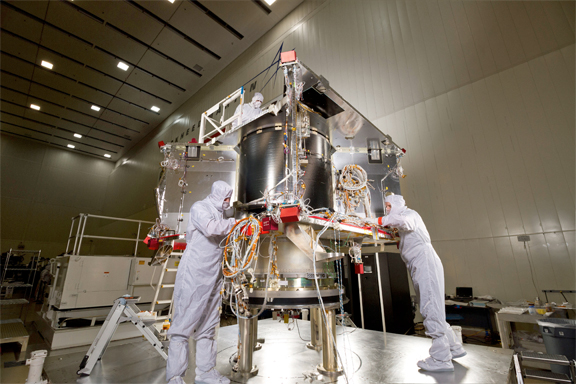[SatNews] In a clean room facility near Denver, Lockheed Martin [NYSE: LMT] technicians began assembling a NASA spacecraft that will collect samples of an asteroid for scientific study.

OSIRIS-REx during assembly, test and launch operations.
Photo courtesy of Lockheed Martin.
Working toward a September 2016 launch, the OSIRIS-REx spacecraft will be the first U.S. mission to return samples from an asteroid back to Earth. OSIRIS-REx—which stands for Origins, Spectral Interpretation, Resource Identification, Security, Regolith Explorer—is going to Bennu, a carbon-rich asteroid that could hold clues to the origin of the solar system and host organic molecules that may have seeded life on Earth. The assembly, test and launch operations (ATLO) phase is a critical stage of the program because it is when the spacecraft physically comes together. Over the next six months, technicians will install on the spacecraft structure its many subsystems, including avionics, power, telecom, mechanisms, thermal systems, and guidance, navigation and control.
“Building a spacecraft that will bring back samples from an asteroid is a unique opportunity,” said Rich Kuhns, OSIRIS-REx program manager at Lockheed Martin Space Systems. “We can feel the momentum to launch building. We’re installing the electronics in the next few weeks and shortly after we’ll power-on the spacecraft for the first time.”
During ATLO, the science instruments are being delivered from the mission’s partner institutions to be integrated with the spacecraft. Once the spacecraft has been fully assembled, it will undergo rigorous environmental testing this fall.
“ATLO is a turning point in the progress of our mission. After almost four years of intense design efforts, we are now starting flight system assembly and integration of the science instruments,” said Dante Lauretta, principal investigator from the University of Arizona, Tucson. “In just over 500 days, we will begin our seven-year journey to Bennu and back. This is an exciting time.”
On March 30, the OSIRIS-REx project officially received authorization to transition into the next phase of the mission, Phase D, after completing a series of independent reviews verifying that the program’s technical, schedule and cost elements are all on course.
NASA's Goddard Space Flight Center in Greenbelt, Maryland, will provide overall mission management, systems engineering, and safety and mission assurance for OSIRIS-REx. Lockheed Martin is building the spacecraft and will provide spacecraft mission operations. OSIRIS-REx is the third mission in NASA's New Frontiers Program. NASA's Marshall Space Flight Center in Huntsville, Alabama, manages New Frontiers for the agency's Science Mission Directorate in Washington.


